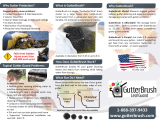
CARE AND MAINTENANCE
Interior and Exterior Doors (JCM005)
3
BASIC INSPECTIONS AND MAINTENANCE - CONTINUED
WEATHERSTRIP AND SWEEP INSPECTION
Inspecting and maintaining weatherstrip can help avoid costly
structural damage from water leakage and energy loss due to air
and/or water inltration. Replace weatherstrip, that has gaps or is
missing, torn, cracked, brittle, discolored, gummy, or that has no
“bounce back” when pressed down.
Precautions
• Solvents such as mineral spirits or petroleum-based products may
damage or dissolve weatherstrip.
• When using alcohol, always test small area rst to avoid
productdamage.
• Do not allow solvents or silicone to touch surfaces
aroundweatherstrip.
• Do not use abrasives, sanders, or anything sharp
nearweatherstrip.
Light Cleaning
1. Clean with damp cloth or mild soap and water.
2. Rinse and dry thoroughly.
3. Repeat if necessary.
Non Water-Soluble Cleaning
Clean with denatured alcohol on soft cloth. Test on inconspicuous
area rst. If denatured alcohol doesn’t work:
1. Clean with small amount of lacquer thinner on soft cloth. Follow
all instructions and do not get lacquer thinner on berglass.
2. Repeat if necessary.
3. Clean with mild soap and water, then rinse. If unsuccessful,
consider replacing weatherstrip.
Weatherstrip Repair
If weatherstrip is loose or falling out of the kerf:
1. Carefully remove weatherstrip.
2. Apply thin bead of silicone sealant into kerf.
3. Reinstall weatherstrip.
4. Hold in place with tape for 24 hours.
5. Carefully remove tape.
Sweep Inspection
Visually inspect the sweep
for tears and missing
components. If the sweep is
damaged, consider replacing
it. See our product guide for
replacement instructions.
When the door is closed,
the sweep should be
compressed by the threshold
by approximately 1/8". If the
threshold has screws visible
on the top, it can be adjusted by turning the adjustment screws on
the threshold clockwise to lower the threshold or counterclockwise
to raise it. Adjust each screw until the threshold applies uniform
compression on the sweep.
Door
sweep
Threshold
Sealant
Weep gap
Foam
wedge
Foam Wedge Inspection
A foam wedge should be
installed at each lower corner
where the door slab is when
it's closed. If the foam wedge
is torn or missing, call us for
areplacement.
BLINDS BETWEEN THE GLASS
For easiest operation, keep the slats in a fully open position
whileoperating.
Adjustments
1. If the operator comes off of the track, hold the operator at a
sharp angle to the glass and reinsert the two legs under the
track opening.
2. Re-couple the operator magnets.
Re-couple operator magnets
1. Slide the operator until the rst click.
2. Full travel blinds will fully engage when you hear the rst click.
Half travel (those units with a single side operation) will require
you to continue moving the operator up until you hear the
second click. This will ensure the magnets are fully engaged.
EXTERIOR SIDING and PRODUCT SEALANT JOINTS
A proper seal of the joints in
the door system and between
the door and the exterior
surface of the structure will
provide a proper shield from
the elements and will keep
water and/or air from leaking
into the house.
1. Inspect sealant in the
joints for:
• Cracks
• Voids
• Deteriorating areas (e.g. loss of adhesion)
2. Repair damaged sealant with a best quality sealant.
Note! Do not apply sealant to areas where installer or
contractor did not originally seal. Seek professional advice from
an installer or contractor if unsure.
When repairing a sealant joint, 100% silicone sealant is the
most durable, but it cannot be painted. Use 100% polyurethane
sealant if painted. Follow sealant manufacturer’s instructions for
proper application.









